Analyzing Cultural Diversity in Australian Workplaces: A Study
VerifiedAdded on 2020/03/04
|7
|1564
|82
Essay
AI Summary
This essay examines cultural diversity within the Australian workplace, focusing on gender inequality and its impact on organizational behavior. It explores underrepresentation of women in leadership, selective task allocation, and unconscious biases as key issues. The study investigates the causes of gender diversity inequality, including social changes, integration, and generational gaps. It further analyzes the impact of these factors on workplace dynamics. The essay proposes measures for managing these challenges, emphasizing the importance of neutrality, diverse workforces, and inclusive leadership. The conclusion highlights the need for organizations to set leadership targets, enhance professional codes of conduct, and embrace inclusive strategies to foster a more equitable and productive work environment. The paper utilizes references to support its arguments and findings.
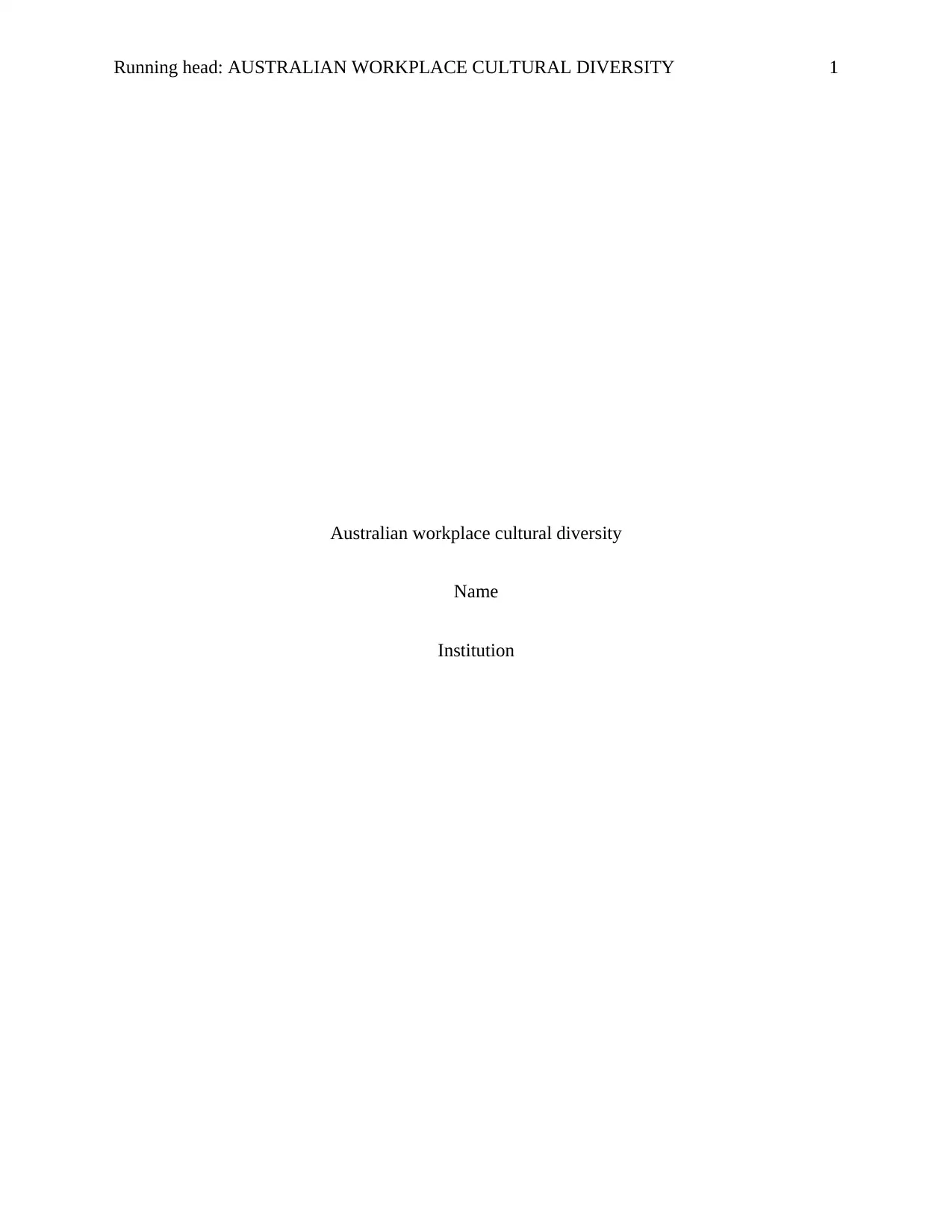
Running head: AUSTRALIAN WORKPLACE CULTURAL DIVERSITY 1
Australian workplace cultural diversity
Name
Institution
Australian workplace cultural diversity
Name
Institution
Paraphrase This Document
Need a fresh take? Get an instant paraphrase of this document with our AI Paraphraser
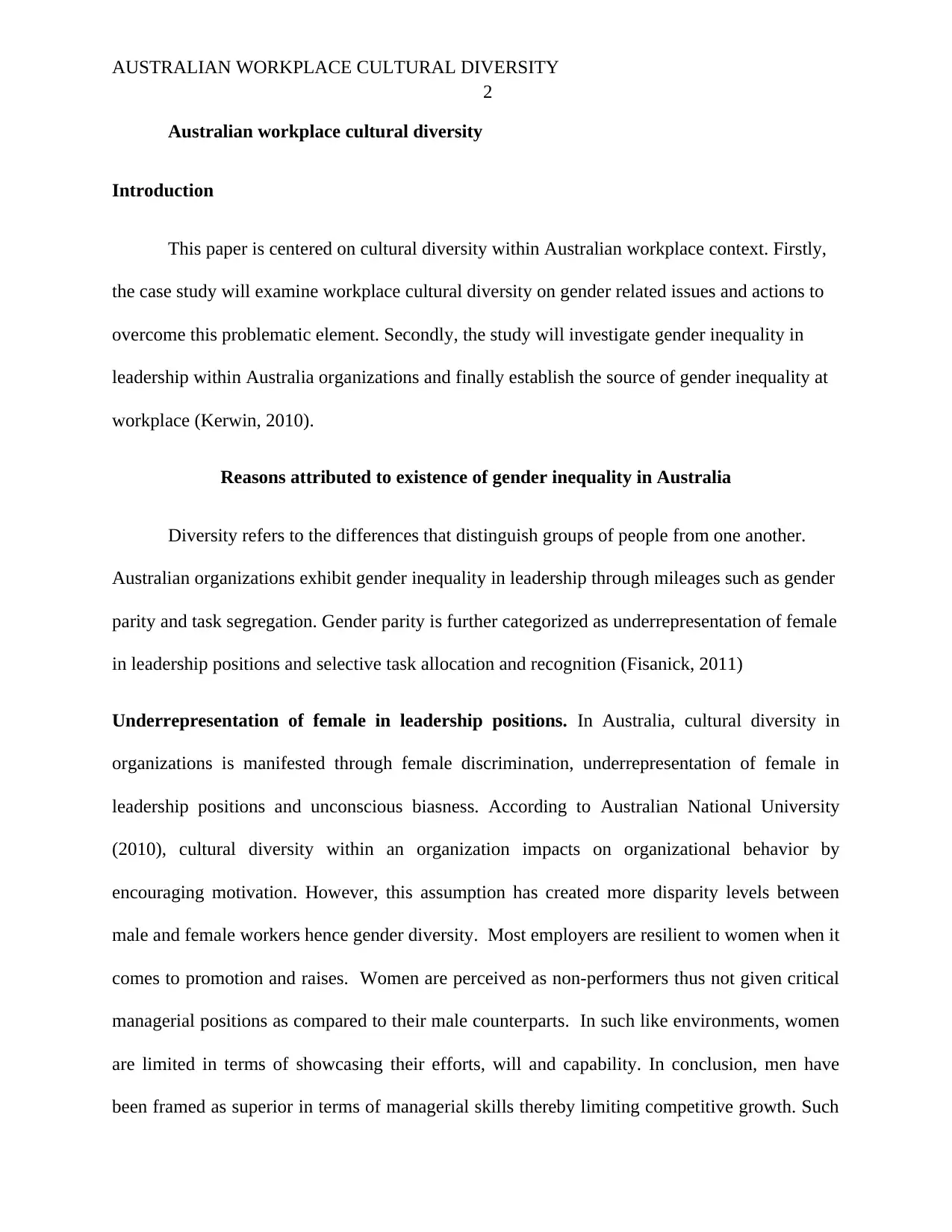
AUSTRALIAN WORKPLACE CULTURAL DIVERSITY
2
Australian workplace cultural diversity
Introduction
This paper is centered on cultural diversity within Australian workplace context. Firstly,
the case study will examine workplace cultural diversity on gender related issues and actions to
overcome this problematic element. Secondly, the study will investigate gender inequality in
leadership within Australia organizations and finally establish the source of gender inequality at
workplace (Kerwin, 2010).
Reasons attributed to existence of gender inequality in Australia
Diversity refers to the differences that distinguish groups of people from one another.
Australian organizations exhibit gender inequality in leadership through mileages such as gender
parity and task segregation. Gender parity is further categorized as underrepresentation of female
in leadership positions and selective task allocation and recognition (Fisanick, 2011)
Underrepresentation of female in leadership positions. In Australia, cultural diversity in
organizations is manifested through female discrimination, underrepresentation of female in
leadership positions and unconscious biasness. According to Australian National University
(2010), cultural diversity within an organization impacts on organizational behavior by
encouraging motivation. However, this assumption has created more disparity levels between
male and female workers hence gender diversity. Most employers are resilient to women when it
comes to promotion and raises. Women are perceived as non-performers thus not given critical
managerial positions as compared to their male counterparts. In such like environments, women
are limited in terms of showcasing their efforts, will and capability. In conclusion, men have
been framed as superior in terms of managerial skills thereby limiting competitive growth. Such
2
Australian workplace cultural diversity
Introduction
This paper is centered on cultural diversity within Australian workplace context. Firstly,
the case study will examine workplace cultural diversity on gender related issues and actions to
overcome this problematic element. Secondly, the study will investigate gender inequality in
leadership within Australia organizations and finally establish the source of gender inequality at
workplace (Kerwin, 2010).
Reasons attributed to existence of gender inequality in Australia
Diversity refers to the differences that distinguish groups of people from one another.
Australian organizations exhibit gender inequality in leadership through mileages such as gender
parity and task segregation. Gender parity is further categorized as underrepresentation of female
in leadership positions and selective task allocation and recognition (Fisanick, 2011)
Underrepresentation of female in leadership positions. In Australia, cultural diversity in
organizations is manifested through female discrimination, underrepresentation of female in
leadership positions and unconscious biasness. According to Australian National University
(2010), cultural diversity within an organization impacts on organizational behavior by
encouraging motivation. However, this assumption has created more disparity levels between
male and female workers hence gender diversity. Most employers are resilient to women when it
comes to promotion and raises. Women are perceived as non-performers thus not given critical
managerial positions as compared to their male counterparts. In such like environments, women
are limited in terms of showcasing their efforts, will and capability. In conclusion, men have
been framed as superior in terms of managerial skills thereby limiting competitive growth. Such
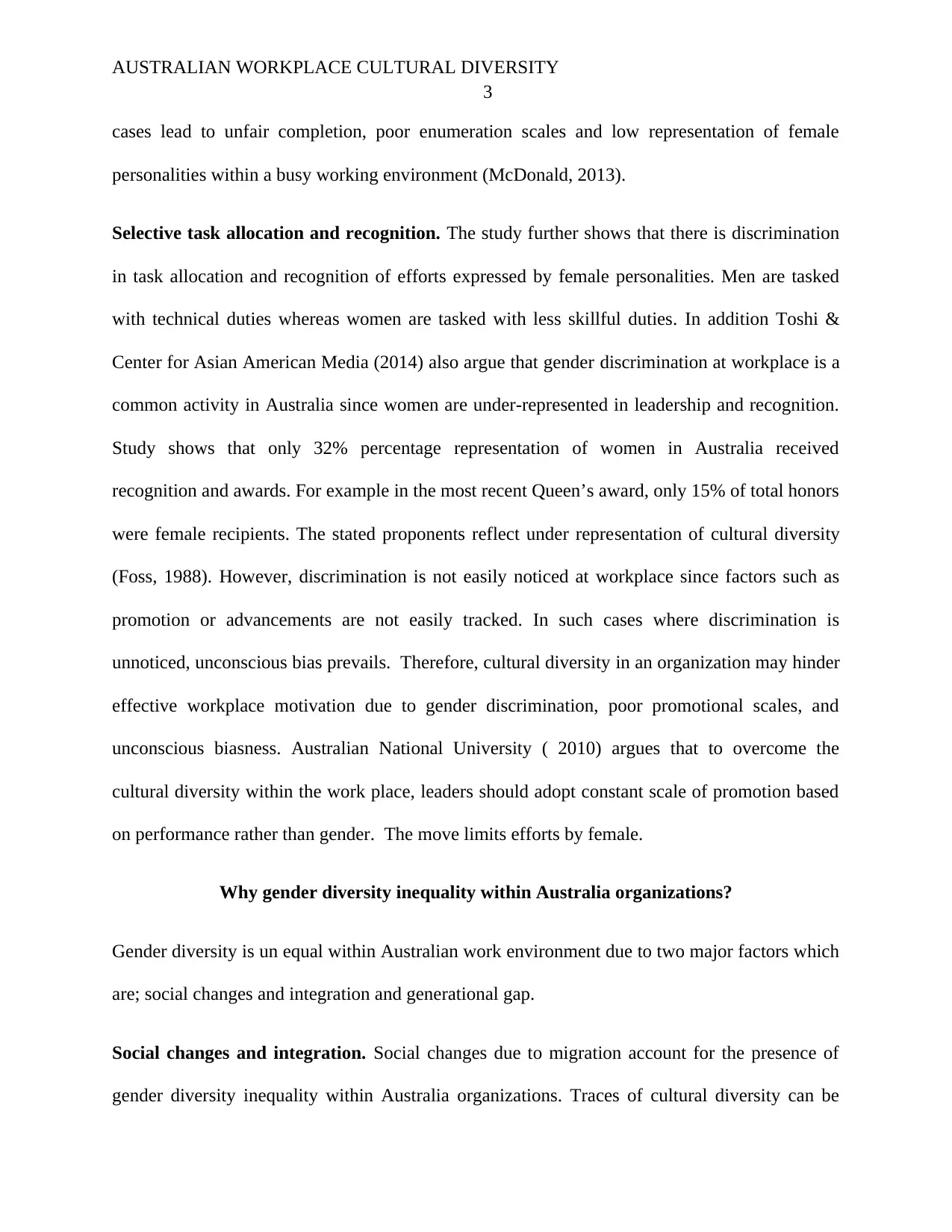
AUSTRALIAN WORKPLACE CULTURAL DIVERSITY
3
cases lead to unfair completion, poor enumeration scales and low representation of female
personalities within a busy working environment (McDonald, 2013).
Selective task allocation and recognition. The study further shows that there is discrimination
in task allocation and recognition of efforts expressed by female personalities. Men are tasked
with technical duties whereas women are tasked with less skillful duties. In addition Toshi &
Center for Asian American Media (2014) also argue that gender discrimination at workplace is a
common activity in Australia since women are under-represented in leadership and recognition.
Study shows that only 32% percentage representation of women in Australia received
recognition and awards. For example in the most recent Queen’s award, only 15% of total honors
were female recipients. The stated proponents reflect under representation of cultural diversity
(Foss, 1988). However, discrimination is not easily noticed at workplace since factors such as
promotion or advancements are not easily tracked. In such cases where discrimination is
unnoticed, unconscious bias prevails. Therefore, cultural diversity in an organization may hinder
effective workplace motivation due to gender discrimination, poor promotional scales, and
unconscious biasness. Australian National University ( 2010) argues that to overcome the
cultural diversity within the work place, leaders should adopt constant scale of promotion based
on performance rather than gender. The move limits efforts by female.
Why gender diversity inequality within Australia organizations?
Gender diversity is un equal within Australian work environment due to two major factors which
are; social changes and integration and generational gap.
Social changes and integration. Social changes due to migration account for the presence of
gender diversity inequality within Australia organizations. Traces of cultural diversity can be
3
cases lead to unfair completion, poor enumeration scales and low representation of female
personalities within a busy working environment (McDonald, 2013).
Selective task allocation and recognition. The study further shows that there is discrimination
in task allocation and recognition of efforts expressed by female personalities. Men are tasked
with technical duties whereas women are tasked with less skillful duties. In addition Toshi &
Center for Asian American Media (2014) also argue that gender discrimination at workplace is a
common activity in Australia since women are under-represented in leadership and recognition.
Study shows that only 32% percentage representation of women in Australia received
recognition and awards. For example in the most recent Queen’s award, only 15% of total honors
were female recipients. The stated proponents reflect under representation of cultural diversity
(Foss, 1988). However, discrimination is not easily noticed at workplace since factors such as
promotion or advancements are not easily tracked. In such cases where discrimination is
unnoticed, unconscious bias prevails. Therefore, cultural diversity in an organization may hinder
effective workplace motivation due to gender discrimination, poor promotional scales, and
unconscious biasness. Australian National University ( 2010) argues that to overcome the
cultural diversity within the work place, leaders should adopt constant scale of promotion based
on performance rather than gender. The move limits efforts by female.
Why gender diversity inequality within Australia organizations?
Gender diversity is un equal within Australian work environment due to two major factors which
are; social changes and integration and generational gap.
Social changes and integration. Social changes due to migration account for the presence of
gender diversity inequality within Australia organizations. Traces of cultural diversity can be
⊘ This is a preview!⊘
Do you want full access?
Subscribe today to unlock all pages.

Trusted by 1+ million students worldwide
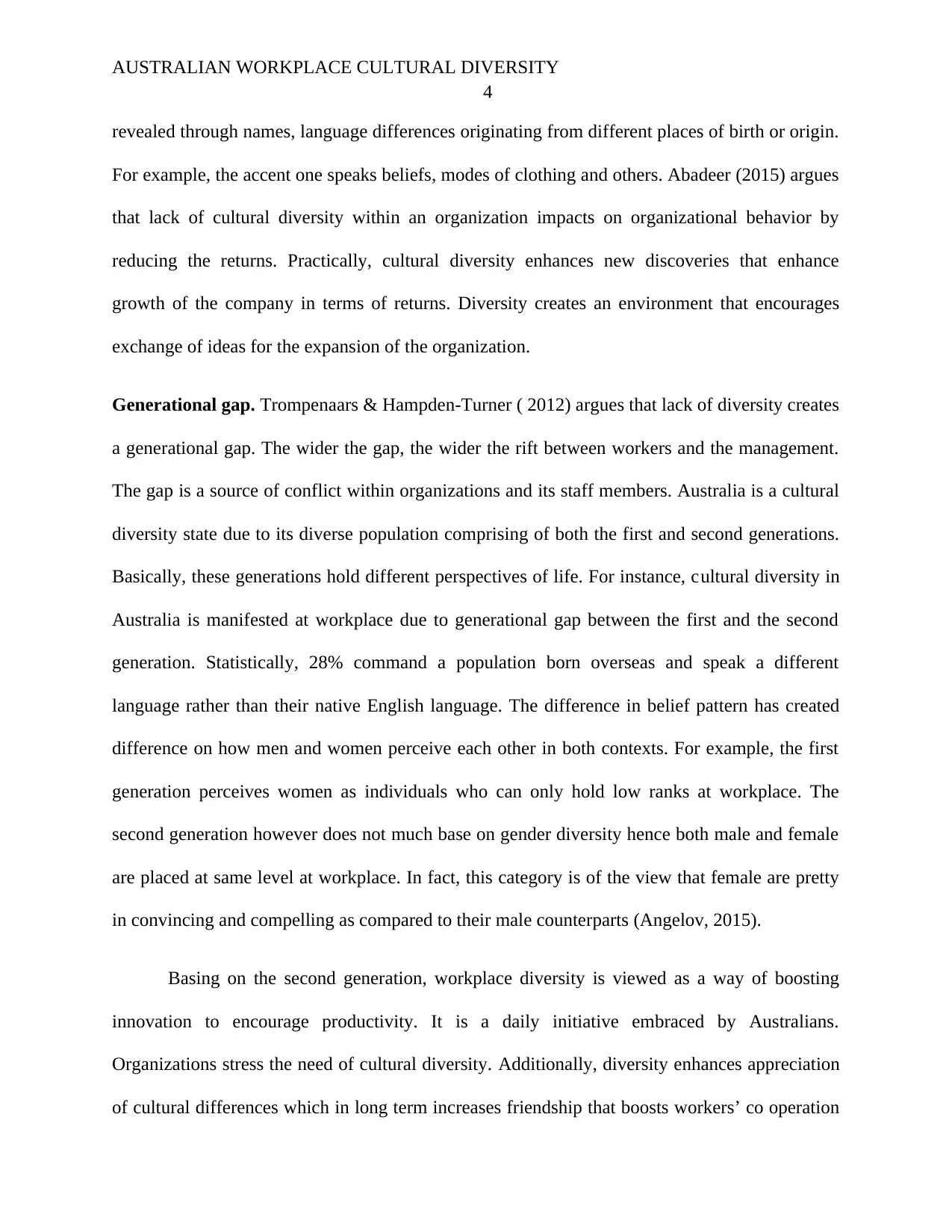
AUSTRALIAN WORKPLACE CULTURAL DIVERSITY
4
revealed through names, language differences originating from different places of birth or origin.
For example, the accent one speaks beliefs, modes of clothing and others. Abadeer (2015) argues
that lack of cultural diversity within an organization impacts on organizational behavior by
reducing the returns. Practically, cultural diversity enhances new discoveries that enhance
growth of the company in terms of returns. Diversity creates an environment that encourages
exchange of ideas for the expansion of the organization.
Generational gap. Trompenaars & Hampden-Turner ( 2012) argues that lack of diversity creates
a generational gap. The wider the gap, the wider the rift between workers and the management.
The gap is a source of conflict within organizations and its staff members. Australia is a cultural
diversity state due to its diverse population comprising of both the first and second generations.
Basically, these generations hold different perspectives of life. For instance, cultural diversity in
Australia is manifested at workplace due to generational gap between the first and the second
generation. Statistically, 28% command a population born overseas and speak a different
language rather than their native English language. The difference in belief pattern has created
difference on how men and women perceive each other in both contexts. For example, the first
generation perceives women as individuals who can only hold low ranks at workplace. The
second generation however does not much base on gender diversity hence both male and female
are placed at same level at workplace. In fact, this category is of the view that female are pretty
in convincing and compelling as compared to their male counterparts (Angelov, 2015).
Basing on the second generation, workplace diversity is viewed as a way of boosting
innovation to encourage productivity. It is a daily initiative embraced by Australians.
Organizations stress the need of cultural diversity. Additionally, diversity enhances appreciation
of cultural differences which in long term increases friendship that boosts workers’ co operation
4
revealed through names, language differences originating from different places of birth or origin.
For example, the accent one speaks beliefs, modes of clothing and others. Abadeer (2015) argues
that lack of cultural diversity within an organization impacts on organizational behavior by
reducing the returns. Practically, cultural diversity enhances new discoveries that enhance
growth of the company in terms of returns. Diversity creates an environment that encourages
exchange of ideas for the expansion of the organization.
Generational gap. Trompenaars & Hampden-Turner ( 2012) argues that lack of diversity creates
a generational gap. The wider the gap, the wider the rift between workers and the management.
The gap is a source of conflict within organizations and its staff members. Australia is a cultural
diversity state due to its diverse population comprising of both the first and second generations.
Basically, these generations hold different perspectives of life. For instance, cultural diversity in
Australia is manifested at workplace due to generational gap between the first and the second
generation. Statistically, 28% command a population born overseas and speak a different
language rather than their native English language. The difference in belief pattern has created
difference on how men and women perceive each other in both contexts. For example, the first
generation perceives women as individuals who can only hold low ranks at workplace. The
second generation however does not much base on gender diversity hence both male and female
are placed at same level at workplace. In fact, this category is of the view that female are pretty
in convincing and compelling as compared to their male counterparts (Angelov, 2015).
Basing on the second generation, workplace diversity is viewed as a way of boosting
innovation to encourage productivity. It is a daily initiative embraced by Australians.
Organizations stress the need of cultural diversity. Additionally, diversity enhances appreciation
of cultural differences which in long term increases friendship that boosts workers’ co operation
Paraphrase This Document
Need a fresh take? Get an instant paraphrase of this document with our AI Paraphraser
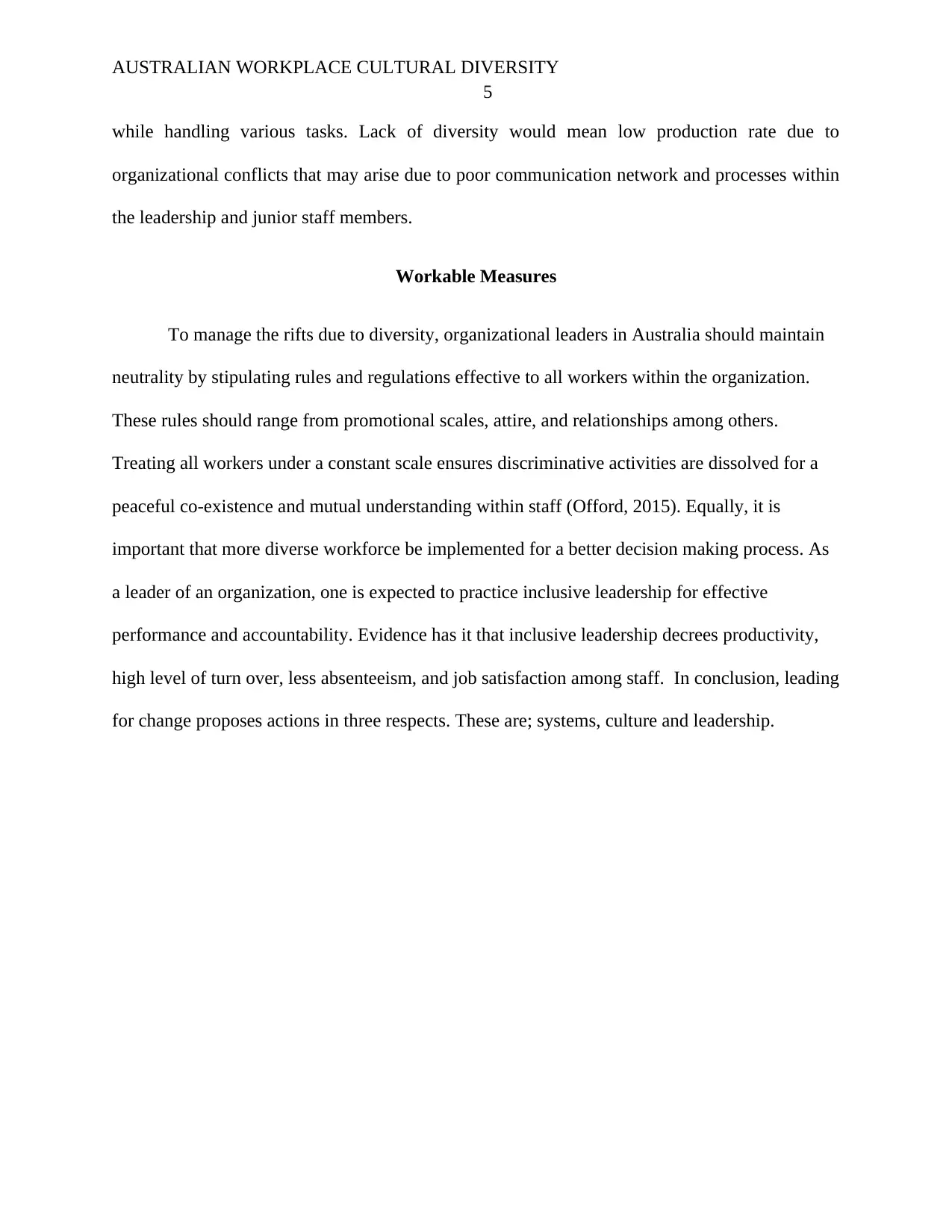
AUSTRALIAN WORKPLACE CULTURAL DIVERSITY
5
while handling various tasks. Lack of diversity would mean low production rate due to
organizational conflicts that may arise due to poor communication network and processes within
the leadership and junior staff members.
Workable Measures
To manage the rifts due to diversity, organizational leaders in Australia should maintain
neutrality by stipulating rules and regulations effective to all workers within the organization.
These rules should range from promotional scales, attire, and relationships among others.
Treating all workers under a constant scale ensures discriminative activities are dissolved for a
peaceful co-existence and mutual understanding within staff (Offord, 2015). Equally, it is
important that more diverse workforce be implemented for a better decision making process. As
a leader of an organization, one is expected to practice inclusive leadership for effective
performance and accountability. Evidence has it that inclusive leadership decrees productivity,
high level of turn over, less absenteeism, and job satisfaction among staff. In conclusion, leading
for change proposes actions in three respects. These are; systems, culture and leadership.
5
while handling various tasks. Lack of diversity would mean low production rate due to
organizational conflicts that may arise due to poor communication network and processes within
the leadership and junior staff members.
Workable Measures
To manage the rifts due to diversity, organizational leaders in Australia should maintain
neutrality by stipulating rules and regulations effective to all workers within the organization.
These rules should range from promotional scales, attire, and relationships among others.
Treating all workers under a constant scale ensures discriminative activities are dissolved for a
peaceful co-existence and mutual understanding within staff (Offord, 2015). Equally, it is
important that more diverse workforce be implemented for a better decision making process. As
a leader of an organization, one is expected to practice inclusive leadership for effective
performance and accountability. Evidence has it that inclusive leadership decrees productivity,
high level of turn over, less absenteeism, and job satisfaction among staff. In conclusion, leading
for change proposes actions in three respects. These are; systems, culture and leadership.
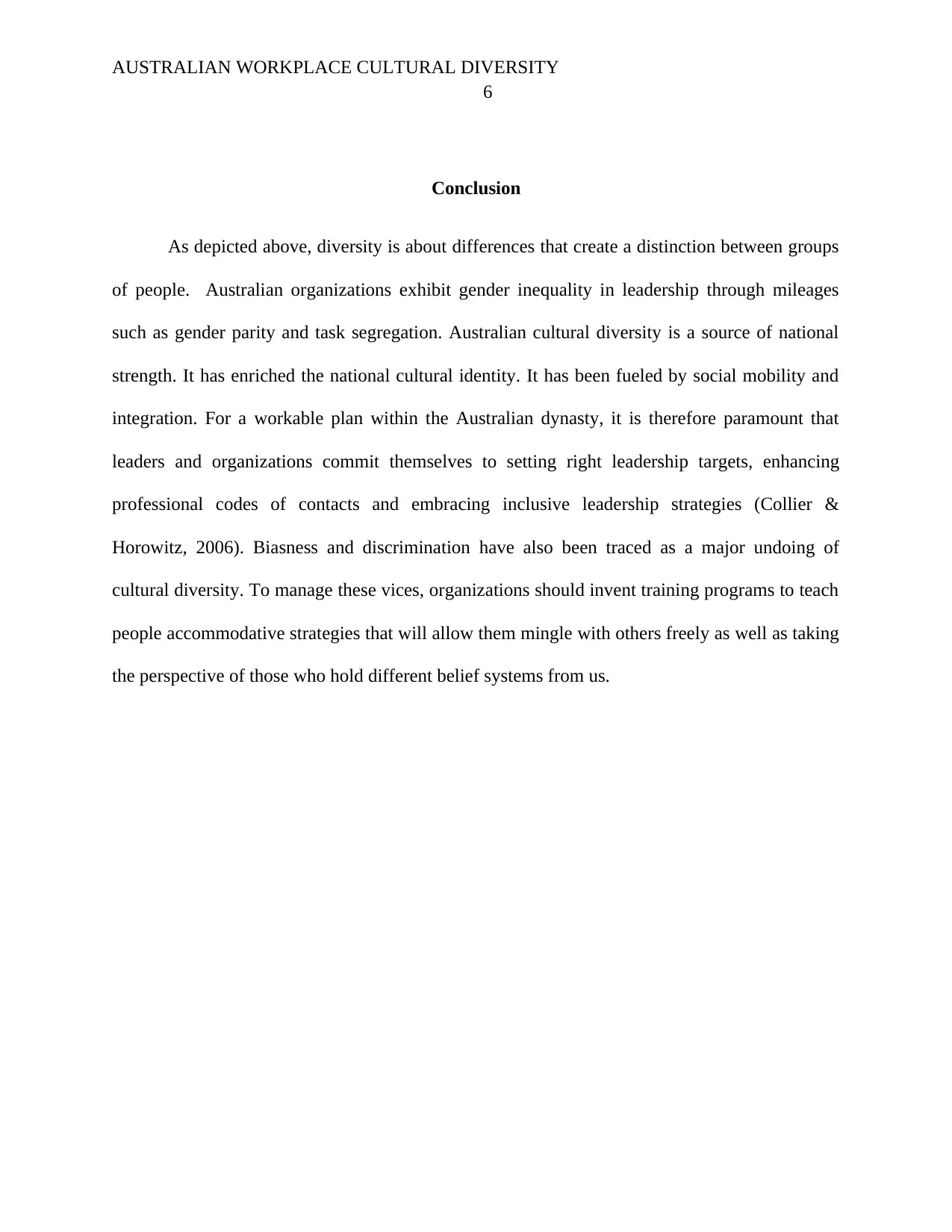
AUSTRALIAN WORKPLACE CULTURAL DIVERSITY
6
Conclusion
As depicted above, diversity is about differences that create a distinction between groups
of people. Australian organizations exhibit gender inequality in leadership through mileages
such as gender parity and task segregation. Australian cultural diversity is a source of national
strength. It has enriched the national cultural identity. It has been fueled by social mobility and
integration. For a workable plan within the Australian dynasty, it is therefore paramount that
leaders and organizations commit themselves to setting right leadership targets, enhancing
professional codes of contacts and embracing inclusive leadership strategies (Collier &
Horowitz, 2006). Biasness and discrimination have also been traced as a major undoing of
cultural diversity. To manage these vices, organizations should invent training programs to teach
people accommodative strategies that will allow them mingle with others freely as well as taking
the perspective of those who hold different belief systems from us.
6
Conclusion
As depicted above, diversity is about differences that create a distinction between groups
of people. Australian organizations exhibit gender inequality in leadership through mileages
such as gender parity and task segregation. Australian cultural diversity is a source of national
strength. It has enriched the national cultural identity. It has been fueled by social mobility and
integration. For a workable plan within the Australian dynasty, it is therefore paramount that
leaders and organizations commit themselves to setting right leadership targets, enhancing
professional codes of contacts and embracing inclusive leadership strategies (Collier &
Horowitz, 2006). Biasness and discrimination have also been traced as a major undoing of
cultural diversity. To manage these vices, organizations should invent training programs to teach
people accommodative strategies that will allow them mingle with others freely as well as taking
the perspective of those who hold different belief systems from us.
⊘ This is a preview!⊘
Do you want full access?
Subscribe today to unlock all pages.

Trusted by 1+ million students worldwide
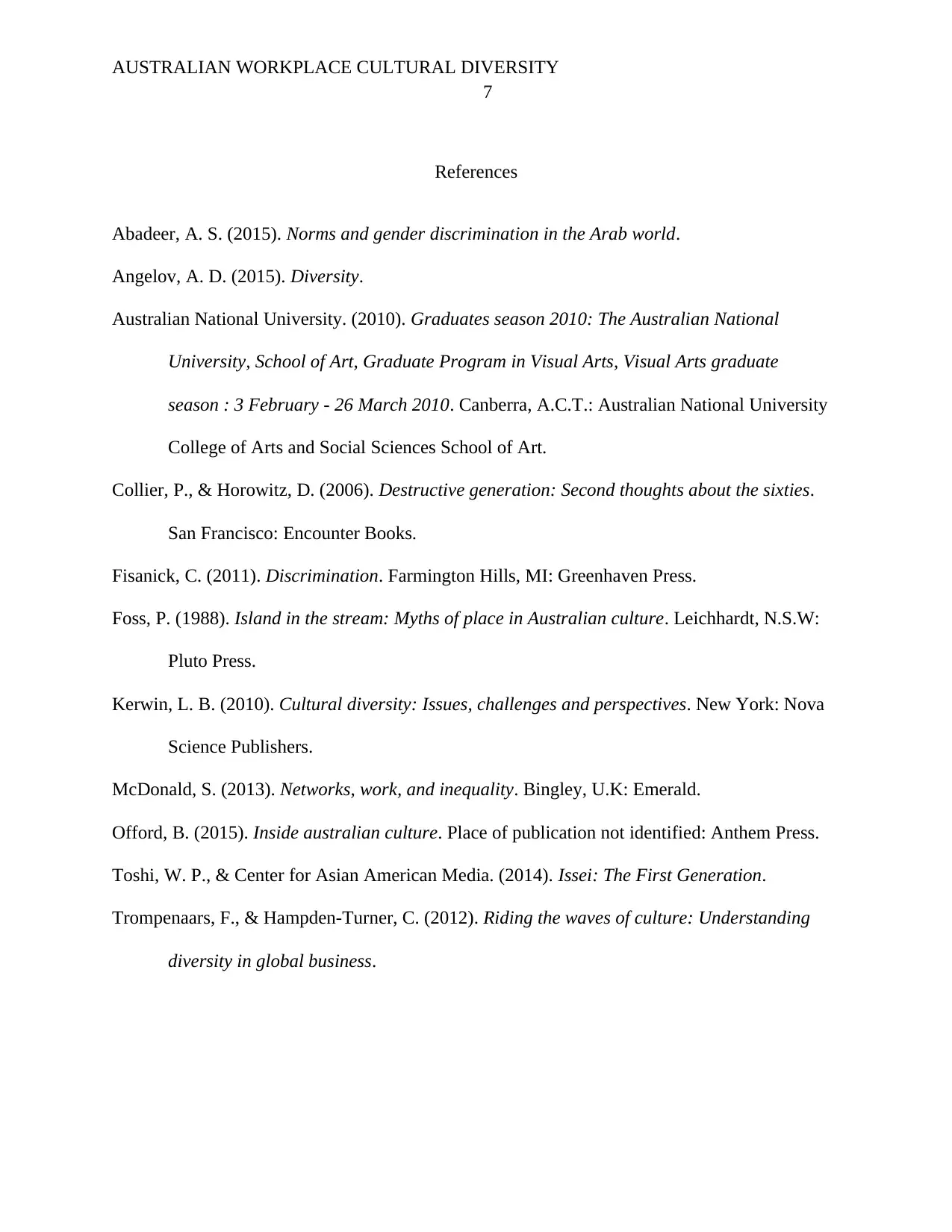
AUSTRALIAN WORKPLACE CULTURAL DIVERSITY
7
References
Abadeer, A. S. (2015). Norms and gender discrimination in the Arab world.
Angelov, A. D. (2015). Diversity.
Australian National University. (2010). Graduates season 2010: The Australian National
University, School of Art, Graduate Program in Visual Arts, Visual Arts graduate
season : 3 February - 26 March 2010. Canberra, A.C.T.: Australian National University
College of Arts and Social Sciences School of Art.
Collier, P., & Horowitz, D. (2006). Destructive generation: Second thoughts about the sixties.
San Francisco: Encounter Books.
Fisanick, C. (2011). Discrimination. Farmington Hills, MI: Greenhaven Press.
Foss, P. (1988). Island in the stream: Myths of place in Australian culture. Leichhardt, N.S.W:
Pluto Press.
Kerwin, L. B. (2010). Cultural diversity: Issues, challenges and perspectives. New York: Nova
Science Publishers.
McDonald, S. (2013). Networks, work, and inequality. Bingley, U.K: Emerald.
Offord, B. (2015). Inside australian culture. Place of publication not identified: Anthem Press.
Toshi, W. P., & Center for Asian American Media. (2014). Issei: The First Generation.
Trompenaars, F., & Hampden-Turner, C. (2012). Riding the waves of culture: Understanding
diversity in global business.
7
References
Abadeer, A. S. (2015). Norms and gender discrimination in the Arab world.
Angelov, A. D. (2015). Diversity.
Australian National University. (2010). Graduates season 2010: The Australian National
University, School of Art, Graduate Program in Visual Arts, Visual Arts graduate
season : 3 February - 26 March 2010. Canberra, A.C.T.: Australian National University
College of Arts and Social Sciences School of Art.
Collier, P., & Horowitz, D. (2006). Destructive generation: Second thoughts about the sixties.
San Francisco: Encounter Books.
Fisanick, C. (2011). Discrimination. Farmington Hills, MI: Greenhaven Press.
Foss, P. (1988). Island in the stream: Myths of place in Australian culture. Leichhardt, N.S.W:
Pluto Press.
Kerwin, L. B. (2010). Cultural diversity: Issues, challenges and perspectives. New York: Nova
Science Publishers.
McDonald, S. (2013). Networks, work, and inequality. Bingley, U.K: Emerald.
Offord, B. (2015). Inside australian culture. Place of publication not identified: Anthem Press.
Toshi, W. P., & Center for Asian American Media. (2014). Issei: The First Generation.
Trompenaars, F., & Hampden-Turner, C. (2012). Riding the waves of culture: Understanding
diversity in global business.
1 out of 7
Related Documents
Your All-in-One AI-Powered Toolkit for Academic Success.
+13062052269
info@desklib.com
Available 24*7 on WhatsApp / Email
![[object Object]](/_next/static/media/star-bottom.7253800d.svg)
Unlock your academic potential
Copyright © 2020–2025 A2Z Services. All Rights Reserved. Developed and managed by ZUCOL.





